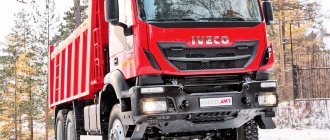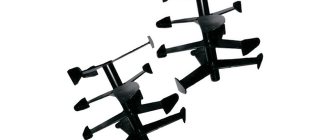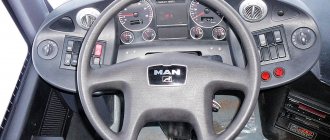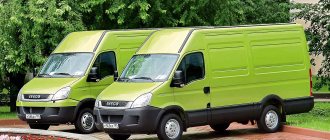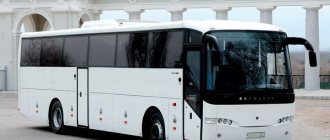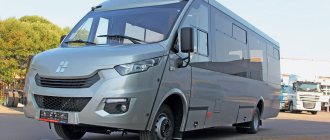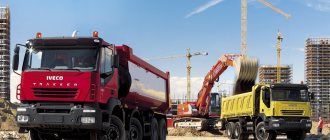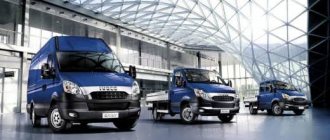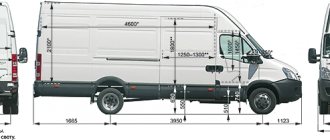| Manufacturer: | IVECO France (France) |
| Model: | IVECO Crossway LE-City 12M (SFR161) |
| Start of sales in Russia: | 2012 |
Andrey Filippov, photo by the author
Do you know what journalists are interested in last when mastering new technology? That's right - the instruction manual. No, this is not due to the “know-it-all” mania, it’s just that a modern description of a car usually represents a kind of Talmud of a hundred or more pages, where everything that is or could potentially be in the car is scrupulously listed. Naturally, in large trucks and buses the thickness of the instructions increases significantly, but there is still not enough time to read them.
So we remember about it only when we sit down to write an article or... when we come across an interesting nuance that we cannot figure out. Agree, when you release the brake pedal while pressing the “D” button, and your bus continues to stand still, it’s interesting. And, for sure, the “shamanic dances with tambourines” look even more interesting from the outside in the form of opening/closing doors, the sequence of pressing buttons on the automatic transmission panel and manipulating the handbrake, and then it turns out that... Yes, that’s exactly how I started testing the IVECO Crossway LE-City 12M
The beaten path
Let's start with the basics: IVECO Crossway LE-City 12M is nothing more than... the well-known Irisbus Crossway LE 12M. Rebranding is the right of any manufacturer, so we won’t dwell on this point, especially since the name change did not make any special changes to the design.
In front of us is the same 12-meter bus. Unlike the more well-known “suburban” versions, the “city” car has a semi-low-floor interior layout, and this version also comes in a three-door version. The last point, whatever one may say, is an undoubted “plus” for Russian conditions, because while it is still possible to achieve regularity of movement with our traffic, it is not yet possible to saturate the fleet with sufficient quantities of equipment. As a result, the 3rd door is the best way to speed up the rotation of passengers at stops and eliminate unnecessary crowding in the cabin.
The interior layout is clearly visible in the photo - the abundance of vertical handrails and the single-row arrangement of seats in the low-floor part are striking. Reasonable. True, older passengers will not be very pleased with the fact that “social” seats, like all others, are installed on podiums. But they all have a folding armrest, and on the front wheel arches there are “one and a half” seats, traditional for European city buses.
The driver's workplace also evokes positive emotions. It’s spacious and everything is at hand, and this despite the asymmetrical arrangement of the control keys, which are grouped on the left side of the panel and on the window sill. I would like to separately mention the ventilation system - the placement of air deflectors in the most unexpected places (under the very ceiling near the windshield, in the area of the door leaves) suggests that the experience of operating in our harsh conditions does not bypass IVECO designers.
Once again I will not lavish praise on the technical part of Crossway. Changing the inscription “Irisbus” to “IVECO” did not in any way affect the positive elements of the layout. A couple of batteries are still mounted transversely on a retractable tray near the floor to make them convenient to service. As before, the air conditioning equipment is mounted on a separate platform, and not hung on the engine, leading to an increase in its vibrations. Etc., etc. – you can’t skimp on quality...
Intercity - luxury bus CROSSWAY 12/12.8M
BODY AND EXTERIOR EQUIPMENT ● Chassis frame welded to U-shaped side members and tubular cross members ● Tubular side frame, casing made of glued thin sheet steel ● Front panel made of pressed sheet steel, spot welded ● Rear panel made of composite material ● Roof – made of stamped steel profiles ● Anti-corrosion protection in a cataphoresis bath, supplemented by spraying a refiller and a final varnish based on polyurethane resins ● Single-leaf front and middle doors, opening outward - 800 mm ● Standard body paint is white; handrails painted yellow ● Protective aprons for monitoring the external spaces of the bus the driver has two electrically installed heated mirrors
INTERIOR EQUIPMENT ● Reclining seats, high, softly upholstered in plush, type 7930. The design of the seats and their arrangement corresponds to the use and increased requirements for comfort, taking into account the space between the individual seats ● Covering the floor and steps with light gray PVC coating ● Covering the sides with blue laminated panels plastic ● Roof lining: middle part of the roof lining made of varnished sheet steel ● Floor lining of luggage compartments made of plywood ● Non-pleated blinds on the side windows and rear window ● Fire extinguisher 2 x 6 kg ● Waste bin in the bus interior (at the front and middle doors) ● The driver's workplace is separated from the passenger compartment with a partition in the upper part of the glazed ● Plastic luggage racks over the heads of passengers in the l#ks design
RADIO ● With CD player ● Driver microphone
ELECTRICAL EQUIPMENT ● Battery 230 Ah / 1250 A ● 2 generators 90 A ● Front fog lights ● Outside temperature sensor ● 24 V and 12 V socket on dashboard ● Socket for charging and starting assistance (for external source) ● Electrical cabinet in left front fuse box ● Illumination of the passenger area with fluorescent lamps ● Activation of an alarm when the doors are opened
WINDOWS / THERMAL COMFORT ● All windows are simple, painted, five of them are with ventilation in the upper part ● 4 emergency exits without ventilation: 2 to the left and 2 to the right ● Thermal and sound insulation of the sides / floor / front panel / pipelines ● 2 ventilation windows in roof in front and behind the bus ● Underfloor 2-speed heating for passengers with warm air distribution (4 elements 1st speed - 5.9 kW 2nd 7.8 kW) with ducts ● Autonomous programmable heating with a power of 30 kW, connected to main tank ● Thermal insulation of the roof
DRIVER'S SEAT / TOUR GUIDE'S SEAT ● Driver's seat with headrest, adjustable, with air spring suspension, with self-winding three-point seat belt ● Driver's seat upholstery same as passenger seats ● Outside temperature indicator on instrument panel ● Electrically controlled front sun visor ● Electronic daily clock tachograph for two drivers ● Additional heating for the driver (3 kW)
TRANSMISSION ● Mechanical, six-speed with power shift ZF 6S.1600 — Cursor
ENGINE ● Iveco Cursor 8, Euro 4 ● Max. power 243 kW (330 hp) at 2,050 rpm. ● Max. torque 1,500 N⋅m at 1,125 -1,600 rpm. ● Cylinder capacity 7.8 liters ● Six-cylinder in-line diesel placed at the rear of the bus, direct injection ● Supercharged by a variable geometry turbocharger on the exhaust, with intake air cooled by an air-to-air cooler ● Electronic control and fuel pump ● Hydrostatically driven fan ● Oil heat exchanger (7.6 dm2) ● Cold start using a throttle built into the supply manifold ● Electric accelerator ● Engine decompression brake ● 100 km speed limiter
REAR AXLE ● Rear axle U167E with simple reduction in the middle ● Total gear ratio 13 x 45 (3.21) – 122 km/h
FRONT AXLE / STEERING ● Front axle with freely suspended wheels and spring suspension ● Hydraulic power steering
SPRING SUSPENSION ● Pneumatic integral with control valves, ensuring a constant body height at any bus load ● Front: 2 combined airbag / 2 shock absorber units; 1 stabilizing rod; 1 spring suspension valve ● Rear: 4 cushions; 4 telescopic shock absorbers, 4 ZN guide rods; 1 stabilizing rod; 2 spring suspension valves
AIR CIRCUIT ● Air compressor 2 cylinders, 630 cm3 (pressure 9.5 bar) ● Air dryer; exhaust valves on air collectors
BRAKES ● Service brakes, pneumatically controlled, front and rear disc ● Anti-locking device ABS ● Anti-spin system ASR
REMEDER ● Electromagnetic retarder for manual transmission ● Integrated hydraulic retarder for automatic transmission ● Retarder can be switched off depending on the main brake
TANK ● Fuel tank 340 l (220 + 120) with filling to the right with lockable doors ● AdBlue tank 60 l
WHEELS AND TIRES ● MATADOR tires size: 295 / 80 R 22.5 ● Wheel size: 22.5 x 8.25-10-152 M 22 E ● Spare wheel is located in the front overhang of the bus ● Nut caps on all wheels
VERSION NORTH (FOR DIFFICULT CLIMATIC CONDITIONS) ● Double glazed side windows ● Double glazed driver's window ● Electric heating of front doors ● Insulation and defrosting of front door steps ● Reinforced thermal and sound insulation of sides / floor / roof / front panel / pipelines ● Radiator insulation ● Electrically heated front door glass ● Heated driver's seat ● Additional heater in the middle doors (1st speed – 5.2 kW, 2nd speed 7.8 kW) and in the front part ● Independent heater 35 kW ● Heated door control cylinders ● Increased airflow windshield ● Heating cabinet for frost protection of windshield and driver's glass ● Reinforced shock absorbers for difficult conditions ● Pillows in North version ● Coolant diluted by – 45 °C ● Heating of engine fuel ● Heating of fuel independently of heater
Italian-French product
And let’s return to “shamanic dances” again. The driver part started exactly as I described. The bus categorically did not want to move, despite all sorts of tricks on my part. The “ambush” turned out to be simple - before pressing the “Drive” button on the automatic transmission, the brake pedal must be “pressed firmly.” That is, if you just lightly press the pedal, the gear will not engage - safety precautions, however.
Subsequently, the test drive took place in normal mode, with splashes from under the wheels and with the “brushes” turned on, monotonously brushing drops from the windshield. By the way, on the IVECO Crossway LE-City 12M the fan-type windshield wipers performed well - the uncleaned areas at the edges of the glass are not critically small. I like it.
The 330-horsepower engine pleased with its acceleration dynamics. Perhaps it is even too good - at least, with an empty cabin, the bus accelerates as if it is going to not give the minibuses a single chance to intercept passengers. It is clear that more than a hundred people permitted passengers will moderate his ardor, but nevertheless...
I would especially like to mention the retarder. Either I haven’t tested large buses in urban dynamic mode for a long time, or on the IVECO Crossway LE-City 12M Voith (this is the retarder installed here) works perfectly! I pulled the right steering column switch towards position I - and now there is a deceleration, and if I move it to position IV, the bus begins to slow down so intensely that if there were passengers in the cabin, I would certainly hear a couple of not at all friendly words.
For a 12-meter IVECO Crossway LE-City 12M it turned out to be quite good in maneuvering. Relatively thin side pillars allow you to perfectly see everything around when turning - neither a pedestrian, nor even a car can hide. And the sense of dimensions is very accurate. A very suitable option for city traffic.
Two things upset me. Firstly, such a convenient-looking system of leaning-sliding doors actually played a cruel joke on the right rear-view mirror. In the open position, the front door completely blocks the view, and it’s not that difficult to control the process of passenger rotation - it’s simply impossible! Only the edge of the door is reflected in the lens. To be honest, I don’t know how to solve this problem, because the designers calculated all the distances so clearly (we must give them credit) that the shutter freezes literally 1 cm from the mirror, so I didn’t dare to move it somehow.
Secondly, for our reality, a city bus needs a full-fledged cabin with a separate entrance on the starboard side. The fact is that during peak traffic hours, passengers always accumulate at the doors, including those in front. Because of this, everything that happens to the right of the bus is out of the driver's field of vision. As a result, he has to resort to all sorts of tricks to avoid getting knocked out on the right. Alas, referring to foreign experience, many forget that there, unlike Russian reality, it would never occur to anyone to stand near the door or “hang over the driver’s soul.” To be fair, I note that the cabin option offered in the test car is perhaps the best solution of this type.
Under the sound of rain...
The Crossway family is well known in Russia.
More than half of all Crossway 12M produced work with us, of which 224 cars are in the Khanty-Mansiysk Autonomous Okrug. The “twins” of our today’s hero, the Irisbus Crossway LE 12M (albeit in a two-door version), can be found on routes in Moscow, the Moscow and Kaliningrad regions, and in the Khabarovsk Territory - the cars were delivered back in 2012–2014. A large number of Crossways operate as service buses mainly in the oil and gas sector. And most importantly, not a single machine is suspended from operation due to a technical malfunction, and most of the machines operate in the north of the country, where operating conditions are not at all sweet. Technical characteristics of the IVECO Crossway LE-City 12M bus
| Total weight, kg | 18 000 |
| Curb weight, kg | 10 480 |
Passenger capacity, persons
| 115 31 1 |
| Luggage compartment capacity, m3 | 6 |
| Permissible load on 1st/2nd axles, kg | 6500/11 500 |
Engine:
| IVECO F2B Cursor 8 Turbodiesel 7790 330 at 1550–2020 min-1 1500 at 1125–1550 min-1 |
Transmission
| VOITH D864.5 GMP 4/1 |
| Suspension | Pneumatic, front – independent |
| Brake system | Pneumatic |
| Wheel formula | 4x2 |
| Minimum turning radius, m | 9550 |
| Fuel tank capacity, l | 320 |
Perhaps it is the fact that the buses have proven themselves well in this harsh region and enjoy well-deserved prestige among fuel companies that allows IVECO representatives to look into the future with such confidence. At least, this is one of the few European companies that actively participates in a specialized event (the World of Buses festival) and from year to year brings one or another previously undemonstrated model to Kolomna.
As it turned out, at present there are not many analogues of the semi-low-floor urban IVECO Crossway LE-City 12M on our market, especially with the 2-2-2 door formula. Offhand you can name the LiAZ-5293, the MAZ 1034 family, the semi-low-floor version of the NefAZ-5299 and, with a slight stretch, the Golden Dragon XML6125CR (it has a 3rd single-leaf door). There is also the MAN Lion's City A78, but it only has two doors, and that's probably all. Modern trends in transferring all urban transport to “low-floor” ones are understandable when it comes to megacities like Moscow or St. Petersburg. But if we talk about smaller cities and regional centers, then questions immediately arise about the ability to properly operate (quality of roads) and maintain (qualification of personnel, capabilities of the repair zone) such machines. And the prices are steep.
Against this background, IVECO Crossway LE-City 12M looks like a good choice. The car has already been tested and suits both drivers and passengers. As for the price - “free cheese is only in a mousetrap”, and the downtime of a machine purchased on credit is also a “moustrap”...
The car was provided for testing
Crossway Line Manual/Automatic Transmission
Number of seats: 45+47 Dimensions: 11,995 x 2,550 x 3,145 PROMOTION! SPECIAL PRICE 11,000,000 rubles. only until 12/31/2016 Karosa Crossway Line with the appropriate body length is quite spacious, has a passenger capacity of 100 people, thanks to modern technologies it is easy to operate and comfortable for passengers. It has two passenger doors with low entry steps. Not every bus has such an attractive service interval - 80,000 km.
being the oldest dealer of IVECO in Russia, we thank you for your interest in our company, and, with the hope of further mutually beneficial cooperation, we bring to your attention the City bus - Karosa Crossway Low Entery City (City) capacity
: up to 115 people
City low-floor bus Karosa Crossway Low Entery City is the optimal bus for intracity transportation. It has wide door aisles and large row spacing, low landing areas, and large storage areas in front of the exit portals. This bus model has increased passenger capacity - up to 115 people, low ground clearance, but increased stability and strength of the hull.
The middle class bus is designed to transport passengers on urban, suburban and intercity routes. Buses on IVECO chassis are the ideal choice for solving transport problems on routes of various lengths and a new tool for creating a reliable and profitable transport system, as well as a natural choice for those who want to find the optimal solution in the field of passenger transport for many years.
Karosa Crossway LE LINE (suburb/city) Total length, mm 12,800 Total width, mm 2,550 Total height, mm 3,145
Engine model IVECO Cursor F2B, 330 hp, Euro 4 Transmission ZF 6S1600, mechanical, synchronized (6+1 rear) intarder, electrically controlled parking brake Axles (front/rear)
Air system
Depreciation
IR 75E, independent / MERITOR
compressor 630 cm3 (9.5 bar), air dryer, oil separator, two air springs and two telescopic shock absorbers in front, four air springs and four telescopic shock absorbers in the rear. Tires and wheels 275/70 R 22.5, tubeless Fuel tank volume, l 200 Number of passengers, persons. 49 + 37 seats Doors 2 pcs. Braking system ABS/ASR, disc brakes (front and rear), in the state with open doors - acceleration blocking with a switch. Electrically controlled parking brake
